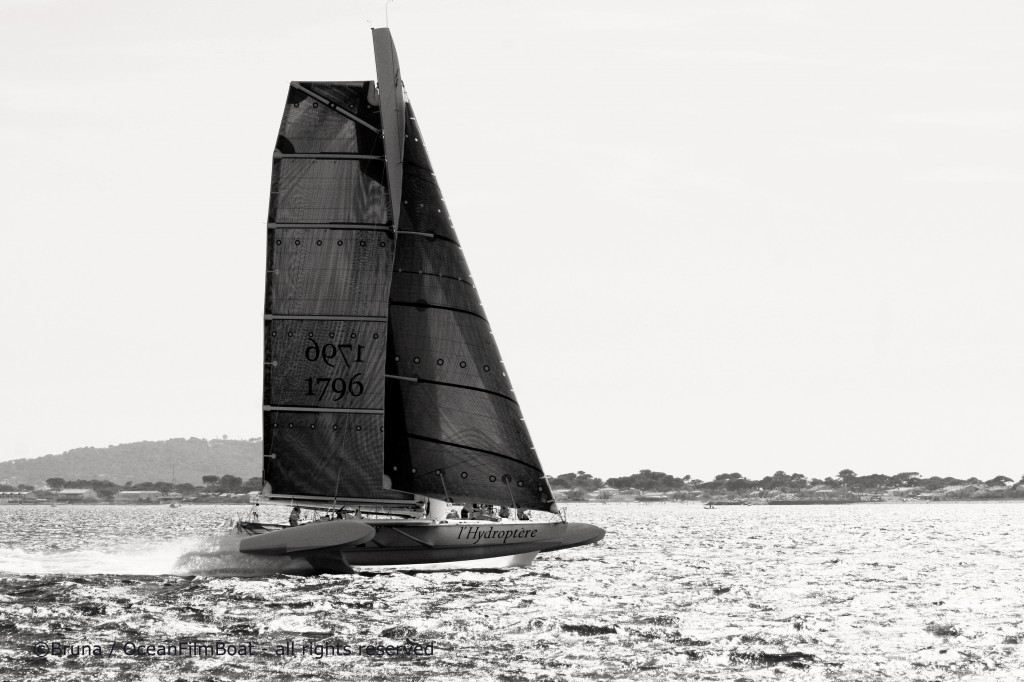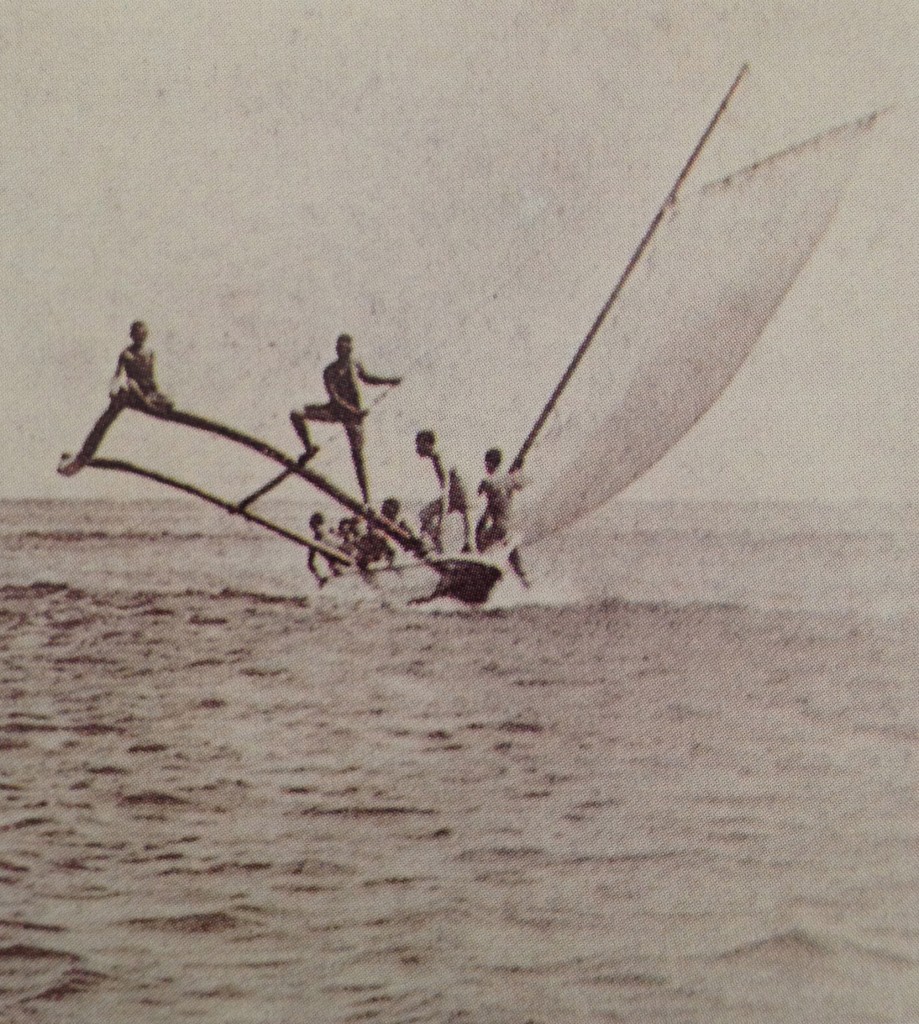l’Hydroptère DCNS: Pure Sensation
Categories: Hydroptere
“Pure Sensation”…
That is what one feels when sailing, albeit flying, onboard “l’Hydroptère DCNS”.
In 2009 this foiled trimaran broke the mystical barrier of 50 knots by clocking 51.36 knots (57.54 mph – 92.6 km/h) both over the 500 meter distance and over 1 nautical mile.
“l’Hydroptère DCNS” Team is currently on the West Coast in line to attempt to break yet another record: the Transpacific Los Angeles (Fermin Point) – Honolulu (Diamond Head lighthouse) record over these 2,215 nautical miles which has been set by Olivier de Kersauson’s 111-foot trimaran “Geronimo” with 4 days, 19 hours and 31 minutes, at an average speed of 19.17 knots (35.5km/h or 22.06 mph).
They are tuning the rig to average a speed of 30 knots over time and distance (34.52 mph – 55km/h). With swells over 6ft being a threat to capsize, they are playing the patience game: waiting for window of clement weather. Rather than ‘faire des ronds dans l’eau” bobbing around, they are sailing in the San Francisco Bay to test the Northern California waters around America’s Cup World Series events.
Beside the human feat, the fascination around “l’Hydroptère DCNS” resides in its technological and scientific evolution as well as in the collaboration of high performance sailing knowledge with aeronautical industry engineering and l’Ecole Polytechnique Fédérale de Lausanne (EPFL). Many contributors to the project are confirmed members of Dassault Aviation (Falcon Jet) and Airbus Industries.
Since her inception, “l’Hydroptère DCNS” has been in constant research & development to keep on attaining new goals and keeping the vision of legend Eric Tabarly alive and Alain Thébault’s dream a reality.
In the early 70’s, Eric Tabarly was tooling with the concept of a “poisson volant” (flying fish) however his wealth of experience and sea exploits were limited by the materials of these days. A first attempt to what could be an Hydroptère was first designed in 1976 from a 19ft / 6 m Tornado hull with foils. That model was set aside for future R & D, meanwhile Eric Tabarly mentored Alain Thebault in his search for a perfected Wings (Ptere in Greek) on Water (Hydros).
In the meantime, in 1979, Tabarly went ahead and designed, with the Dassault Aviation engineering team, the innovative 54ft “Paul Ricard” trimaran, a clear benchmark in sailing and specifically multihull sailing.
In spite of its structure made of aluminum and the limited budget at hand, he established a new Transatlantic record by crossing in 10 days 5 hours 14 minutes 20 seconds for an average speed of 12.15 knots, blowing out of the water the long standing Transatlantic record established by venerated Charlie Barr, whose record had stood undefeated for 75 years.
Charlie Barr had distinguished himself as a three time America’s Cup defender. With such celebrated feats, he helmed the luxurious monohull 1903 3-masted 185ft / 56.30m schooner “Atlantic” to victory in the 1905 Kaiser Cup. Barr established the 12 days 4 hours 1 minute 19 seconds record with an average speed of 10.20 knots many tried to beat… until Tabarly’ pulverized it on his 54ft / 16.45m “Paul Ricard” a craft one third the 185ft / 56.30m LOA (Length Over All) of the famed schooner (*).
Not insensitive to the appeal of the Eric Tabarly’s magnetic legend, then still alive and in the height of his fame and celebration, along with the calling of the offshore distant horizons, Alain Thébault felt his dream of flying on water was not so far fetched.
With the advent of carbon fiber and other high tech materials, and his relentless convection, “l’Hydroptère DCNS” is a technological experimental dream machine.
“l’Hydroptère DCNS” Teams are the first to say the boat has been ‘built, destroyed, repaired, tweaked, pulled apart again, broken again, evolved again to be reassembled yet again” to keep studying its performance and further its adaptability. Many a foil design, foil immersion level, composite materials and model have been tested in a high speed water tunnel. Special attention has been brought to the overall structural behavior in view of extreme sailing speed to test, review and prevent strains and stresses.
We were off Hyères, south of France, I was still riding the high of having been on board as the 5th man on Randy Smyth’s Extreme 40 “Tommy Hilfiger” during one of the Hyères iShare races. We noticed at a great distance what was sea spray associated with a tall sail.

Hydrofoil trimaran “L’Hydroptere ” as caught by “Water-Wizards” off Hyères on a test run at around 32 knots.
Not your common sight! Simply imagine : a structure standing 9 story tall on its base of 60 feet long and 79 feet wide and slicing the seas on hydrofoils which now can sustain speeds up to 56 knots (64 mph – 103.72 km/h)!
Teased and curious, we called upon all our seahorses, and to our delight, ”l’Hydroptère DCNS” was out testing. Being along with them at what might have been 32+ knots was simply exhilarating. One could sense something grand was about to unfold. Their sponsors colors were yet to be on their hulls and floaters making her a shimmering white flying fish as we see in southern seas.
Flying they are. The skipper is sitting anywhere between 10 and 20ft above the waterline with the boat surface in the water reduced to less than 22 sqft!
The Dream is Alive!
Speeding up “Water-Wizards” next to “l’Hydroptère DCNS” was therefore an even greater thrill for me as if looking “back to the Future”.
Being raised in the Society Islands, I so looked forward to watching what turned out to be the last of races of the sailing single outriggers. The highlight was when one of the crew would step out of the main hull to go stand near the floater (hama) leaning out from the sail as their ancestors had done for years.
Another childhood memory kicked in.
It was no secret that the ‘marara’ (flying fish in Tahitian) was teasing Tabarly. He wished he could design and sail a boat as fast, light and elegant. My father, Jean-Pierre ‘Le Barbu’ built a strong word-of-mouth following amongst great sailors arriving in Tahiti on boats having weathered and, at times, suffered the crossing of the Pacific Ocean to find light yet strong solutions to what had broken or ready to let go. I was often privileged to find myself in the company of the Greats and at times, would join him on board these legendary sailboats. Meeting such illustrious sailors as: Eric Tabarly, Bernard Moitessier, Alain Colas, Olivier de Kersauson, Antoine, and the likes, was a blend of intrigue, delight and reverence. Most were men of a few words, however their mannerisms, their passion and conviction, their small habitats, their feats were adding to their hypnotic personalities. Eric Tabarly, who many considered stern, dark and strict, had such presence that even in my younger years, I was taken by his brilliant and smart blue eyes. They had seen so much and experienced many an horizon. With Eric Tabarly, there was also a sense of urgency, he was not one to be overtaken by ”harbor fever” that many sailors feel in the tropics as they find it difficult to cast off a safe harbor after having faced challenging seas. Tahiti, however much he enjoyed the island, was a stop on an ever ending itinerary exploring the Seas, coming back with one of his famed “Penduick”, exploring his own limits which each passage, pushing a new boat.
This is a new chapter for “l’Hydroptère DCNS”. This Transpacific record attempt will actually be their first run into long distance non-stop offshore wide open seas.
For the upcoming record setting, the lined-up Crew will be headed by Alain Thébault himself and will include such prominent offshore sailing confirmed figures as: Jean le Cam and Yves Parlier (known amongst others for the Vendee Globe , both have crewed with Eric Tabarly) , Jacques Vincent (co-skipper), and Luc Alphand (also known in extreme cycling and skiing).
Wishing Fair Steady Winds to “l’Hydroptère DCNS” and awaiting with much anticipation their news upon crossing Diamond Head lighthouse!
Bon Vent, Bonnes Vagues… Fair Winds, Smooth Waves!
Bruna
(*) One would have to wait until 1997 for another monohull to align itself to the “Atlantic” Charlie Barr record: Sweden’s Ludde Ingvall 80ft / 24.50m sloop yacht “Nicorette” in completing the crossing in 11 days 13 hours 22 minutes.



